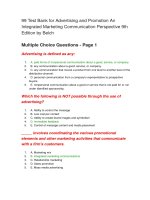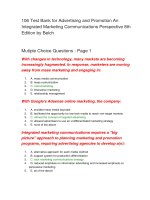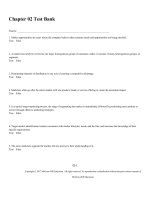Lecture Advertising and promotion: An integrated marketing communications perspective (10/e): Chapter 22 - George E. Belch, Michael A. Belch
Bạn đang xem bản rút gọn của tài liệu. Xem và tải ngay bản đầy đủ của tài liệu tại đây (691.28 KB, 18 trang )
Chapter 22
Personal
Selling
Copyright © 2014 McGraw-Hill Education. All rights reserved. No reproduction or distribution without the prior written consent of
McGraw-Hill Education.
Personal Selling
Selling through a persontoperson communications
process
Affected by increased emphasis on customer
relationship management
Importance varies for each firm depending on:
Nature of the product or service being marketed
Size of the organization
Type of industry
Copyright © 2014 McGraw-Hill Education. All rights reserved. No reproduction or distribution without the prior written consent
of McGraw-Hill Education.
2
Dyadic Communication
Direct and interpersonal communication
Allows sender to immediately receive and evaluate
feedback from receiver
Messages can be changed to address the receiver’s
specific needs and wants
Copyright © 2014 McGraw-Hill Education. All rights reserved. No reproduction or distribution without the prior written consent
of McGraw-Hill Education.
3
Factors that Determine the Role of
Personal Selling
Determining the information to be exchanged
Examining promotional-mix alternatives
Evaluating the relative effectiveness of alternatives
Determining cost-effectiveness
Copyright © 2014 McGraw-Hill Education. All rights reserved. No reproduction or distribution without the prior written consent
of McGraw-Hill Education.
4
Characteristics of Stages of Personal Selling
Evolution
Stages and description Customer needs
Type of
market
Nature and intensity
of competition
Provider - Accepts
orders and delivers to
buyer
• Assumed to
exist
• Not a concern
Sellers’
• None
Persuader - Attempts
to convince anyone to
buy available offerings
• Created
• Awakened
Buyers’
• Undifferentiated
• Slight intensity
Segmented
• Differentiated
• Growing
Prospector - Seeks out • Considered but
prospects with need
inferred
for available offering
and
resources to buy
Copyright © 2014 McGraw-Hill Education. All rights reserved. No reproduction or distribution without the prior written consent
of McGraw-Hill Education.
5
Characteristics of Stages of Personal
Selling Evolution
Stages and
description
Customer needs
Type of
market
Nature and intensity
of competition
Problem solver Matches
available offerings to
solve customer-stated
problems
•
Diagnosed with
attention to
customer input
Participative
•
Responsive and
counteractive with
increasing
resources
Procreator - Creates a
unique offering to
match the buyer’s
needs as mutually
specified,
involving any or all
aspects of the seller’s
total marketing mix
•
•
Mutually defined
Matched with
tailored offering
Coactive
•
•
Focused
Growing in breadth
of market and
service offerings
Copyright © 2014 McGraw-Hill Education. All rights reserved. No reproduction or distribution without the prior written consent
of McGraw-Hill Education.
6
New Role of Salespeople
Surveying
Mapmaking
Guiding
Fire starting
Copyright © 2014 McGraw-Hill Education. All rights reserved. No reproduction or distribution without the prior written consent
of McGraw-Hill Education.
7
Relationship Marketing
Organization’s effort to develop a longterm, cost
effective link with individual customers for mutual
benefit
Customer relationship management (CRM):
Support targeting, acquiring, retaining,
understanding and collaborating with customers
Copyright © 2014 McGraw-Hill Education. All rights reserved. No reproduction or distribution without the prior written consent
of McGraw-Hill Education.
8
Figure 22.4 The Eight Step Personal
Selling Process
Source: From Reds Communications, “The 8 Step Personal Selling Process—Let Us Help You,” www.redscommunications.co.za.
Copyright © 2014 McGraw-Hill Education. All rights reserved. No reproduction or distribution without the prior written consent
of McGraw-Hill Education.
9
Types of Sales Jobs
Order taking: Accomplished by:
Inside order takers Work inside the sales office and receive
orders by phone, mail, or the Internet
Field order takers Travel to customers to get their orders
Creative selling: Getting an order by:
Assessing a situation and determining the needs
Presenting capabilities to satisfy the needs
Missionary sales: Introduce new products,
promotions, and/or programs with the actual order to
be taken
Perform a support role
Copyright © 2014 McGraw-Hill Education. All rights reserved. No reproduction or distribution without the prior written consent
of McGraw-Hill Education.
10
Traits of a Salespeople
Successful
Most helpful to
Most objectionable to
salespeople
customers
customers
• Knowledgeable
• Knowledge
• Unprepared
• Professional
• Empathy
• Uninformed
• Thorough
• Well organized
• Aggressive
• Results-oriented
• Promptness
• Undependability
• Problem solving
• Follow-through
• Poor follow-through
• Relationship-oriented
• Solutions
• Presumptuousness
• Customer-focused
• Punctuality
• Calling without
• Responsive
• Hard work
appointments
• Good communicators
• Energetic
• Compulsive talkers
• Reliable
• Honesty
• Problem avoiders
Copyright © 2014 McGraw-Hill Education. All rights reserved. No reproduction or distribution
withoutofthe
prior writtenrespect
consent
• Lack
personal
of McGraw-Hill Education.
11
Advantages and Disadvantages of
Personal Selling
Advantages
• Allows for two-way
interaction
• Tailors the message
Disadvantages
• Inconsistent messages
• Sales force/management
conflict
• Lack of distraction
• High cost
• Involvement in the decision
• Poor reach
process
• Potential ethical problems
• Source of research
Copyright © 2014 McGraw-Hill Education. All rights reserved. No reproduction or distribution without the prior written consent
of McGraw-Hill Education.
12
Ways to Use Advertising to Sell More
Save sales force time
Avoid lengthy explanations
Add impact to the presentation and reinforce selling points
Ego boosters and personal refreshers
Clues to prospects’ interests
Prove a point and create preference
Help prospects to make a decision
Provide followups
Fight lowerpriced competitors
Getting the customer into the act
Copyright © 2014 McGraw-Hill Education. All rights reserved. No reproduction or distribution without the prior written consent
of McGraw-Hill Education.
13
Combining Personal Selling with Other
Promotional Tools
Public relations
Direct marketing
Sales Promotion
Internet
Copyright © 2014 McGraw-Hill Education. All rights reserved. No reproduction or distribution without the prior written consent
of McGraw-Hill Education.
14
Figure 22.12 Factors to Be Considered
in the Sales Review Process
Source: Steve Deist and Rich Johnson, “Developing an Effective Sales Force,” Industrial Distribution.
Copyright © 2014 McGraw-Hill Education. All rights reserved. No reproduction or distribution without the prior written consent
of McGraw-Hill Education.
15
Criteria Used to Evaluate Sales Forces
Measures
Sales results
Sales efforts
Quantitative measures
•
•
•
•
• Sales calls
Orders
Sales volume
• Selling expenses
Margins
• Customer service
Customer accounts
Qualitative measures
•
Selling skills
• Sales-related
activities
Copyright © 2014 McGraw-Hill Education. All rights reserved. No reproduction or distribution without the prior written consent
of McGraw-Hill Education.
16
Characteristics That Improve
Performance Effectiveness
Strength of the field manager
Clear link between company culture and values to
sales strategies
Rigorous management processes that drive
performance
Consistent training that leads to consistent
execution
Courage to change
Copyright © 2014 McGraw-Hill Education. All rights reserved. No reproduction or distribution without the prior written consent
of McGraw-Hill Education.
17
Criteria for Evaluating Personal Selling
Provision of marketing intelligence
Followup activities
Program implementations
Attainment of communications objectives
Copyright © 2014 McGraw-Hill Education. All rights reserved. No reproduction or distribution without the prior written consent
of McGraw-Hill Education.
18









